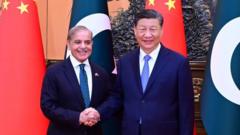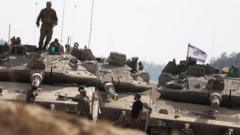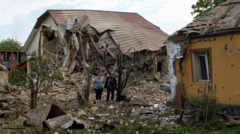The four-day conflict saw both nations claim victory, but experts suggest that China's military technology showcased its capability in combat, raising its profile in the global arms market.
**China's Unexpected Gains from the India-Pakistan Conflict**

**China's Unexpected Gains from the India-Pakistan Conflict**
The recent flare-up between India and Pakistan appears to have inadvertently benefited China's defense industry.
In a dramatic turn of events, the recent four-day military confrontation between traditional adversaries India and Pakistan has led to an unexpected outcome: a potential boost for China's defense sector. With both nations declaring victory in the wake of a ceasefire, the conflict has drawn attention to China's military support for Pakistan, particularly its involvement in aerial combat.
The escalation began on May 7, following a tragic incident where 26 individuals, primarily tourists, were killed by militants in Pahalgam, Kashmir on April 22. In response, India launched "Operation Sindoor," targeting what it labeled as "terrorist infrastructure" within Pakistan. This led to a cycle of retaliatory military actions, which saw both nations deploying drones, missiles, and fighter jets.
Reports suggest that India utilized its French-made Rafale jets alongside Russian aircraft, while Pakistan's aerial response included the Chinese J-10 and J-17 fighters that were co-manufactured with Beijing. Tensions heightened as Islamabad claimed that its jets shot down six Indian planes during the conflict, a statement that the Indian government has not publicly addressed.
The situation sparked significant analysis regarding the performance of the Chinese jets. Reports allege that the J-10 may have had a role in downing Indian aircraft, including the Rafale. Zhou Bo, a retired Chinese military colonel, expressed that the engagement served as a valuable advertisement for Chinese military technology, which had previously lacked real-world combat exposure. This newfound visibility led to a surge in shares for Chinese manufacturers following the clashes.
However, not all analysts are convinced of the Chinese technology's superiority just yet. Professor Walter Ladwig from King's College questioned whether the J-10s had genuinely outperformed their Indian counterparts, emphasizing the need for substantiated evidence regarding the conflict's outcomes.
While Beijing has remained tight-lipped about details of the engagement, unconfirmed reports of Pakistani triumphs reportedly ignited a wave of nationalism across Chinese social media platforms. According to Carlotta Rinaudo, a researcher on China, the perceptions surrounding the conflict matter more than tangible results at this juncture.
China's close relationship with Pakistan is strategic, with investments exceeding $50 billion in various infrastructural projects. Thus, a weakened Pakistan does not align with China's interests. Imtiaz Gul, a Pakistani security analyst, noted the enhanced coordination between Pakistan and China may have taken Indian officials by surprise during this conflict.
The implications of the conflict extend beyond the immediate military confrontation. Experts suggest that how Chinese jet performance is perceived will have ripple effects throughout the global arms trade—where China currently ranks fourth, behind the US, the largest arms supplier globally. Although previous critiques of Chinese military technology have hindered its reputation, this clash has the potential to alter international perceptions.
Despite the aerial engagements, India reportedly maintained its strategic focus by targeting multiple Pakistani military installations, a maneuver that could bolster its global standing, even if overall media coverage concentrated on downed jets.
Moreover, the specter of advanced Chinese military capabilities, particularly with newer models like the J-20 stealth fighter, serves as a potential catalyst for India to expedite its defense modernization efforts in light of growing concerns about the balance of military power in the region.
For the time being, the spotlight firmly rests on China’s defense industry, which appears to be reveling in newfound recognition following claims of its aircraft's success in the latest conflict between India and Pakistan.
The escalation began on May 7, following a tragic incident where 26 individuals, primarily tourists, were killed by militants in Pahalgam, Kashmir on April 22. In response, India launched "Operation Sindoor," targeting what it labeled as "terrorist infrastructure" within Pakistan. This led to a cycle of retaliatory military actions, which saw both nations deploying drones, missiles, and fighter jets.
Reports suggest that India utilized its French-made Rafale jets alongside Russian aircraft, while Pakistan's aerial response included the Chinese J-10 and J-17 fighters that were co-manufactured with Beijing. Tensions heightened as Islamabad claimed that its jets shot down six Indian planes during the conflict, a statement that the Indian government has not publicly addressed.
The situation sparked significant analysis regarding the performance of the Chinese jets. Reports allege that the J-10 may have had a role in downing Indian aircraft, including the Rafale. Zhou Bo, a retired Chinese military colonel, expressed that the engagement served as a valuable advertisement for Chinese military technology, which had previously lacked real-world combat exposure. This newfound visibility led to a surge in shares for Chinese manufacturers following the clashes.
However, not all analysts are convinced of the Chinese technology's superiority just yet. Professor Walter Ladwig from King's College questioned whether the J-10s had genuinely outperformed their Indian counterparts, emphasizing the need for substantiated evidence regarding the conflict's outcomes.
While Beijing has remained tight-lipped about details of the engagement, unconfirmed reports of Pakistani triumphs reportedly ignited a wave of nationalism across Chinese social media platforms. According to Carlotta Rinaudo, a researcher on China, the perceptions surrounding the conflict matter more than tangible results at this juncture.
China's close relationship with Pakistan is strategic, with investments exceeding $50 billion in various infrastructural projects. Thus, a weakened Pakistan does not align with China's interests. Imtiaz Gul, a Pakistani security analyst, noted the enhanced coordination between Pakistan and China may have taken Indian officials by surprise during this conflict.
The implications of the conflict extend beyond the immediate military confrontation. Experts suggest that how Chinese jet performance is perceived will have ripple effects throughout the global arms trade—where China currently ranks fourth, behind the US, the largest arms supplier globally. Although previous critiques of Chinese military technology have hindered its reputation, this clash has the potential to alter international perceptions.
Despite the aerial engagements, India reportedly maintained its strategic focus by targeting multiple Pakistani military installations, a maneuver that could bolster its global standing, even if overall media coverage concentrated on downed jets.
Moreover, the specter of advanced Chinese military capabilities, particularly with newer models like the J-20 stealth fighter, serves as a potential catalyst for India to expedite its defense modernization efforts in light of growing concerns about the balance of military power in the region.
For the time being, the spotlight firmly rests on China’s defense industry, which appears to be reveling in newfound recognition following claims of its aircraft's success in the latest conflict between India and Pakistan.





















